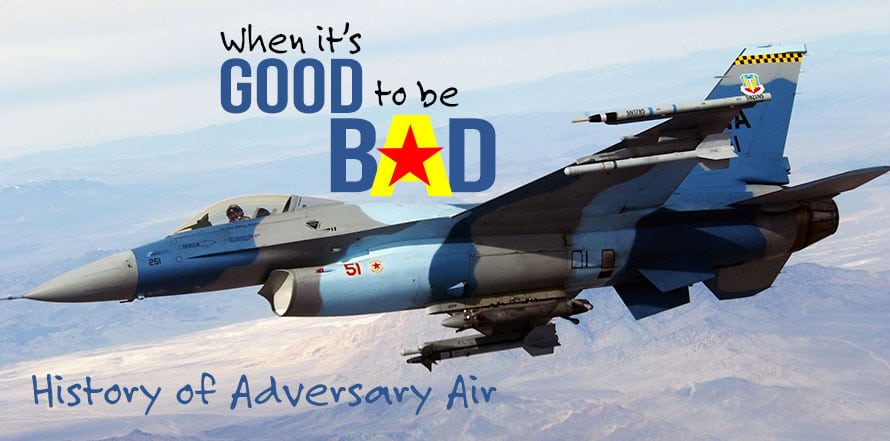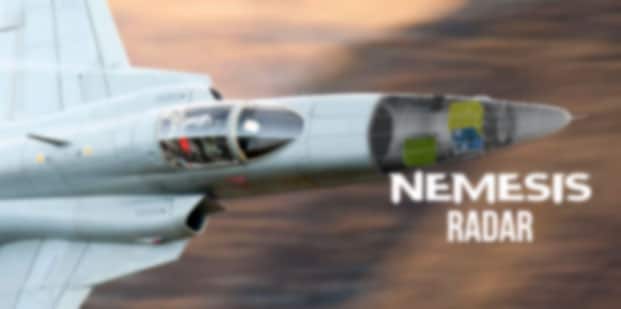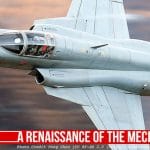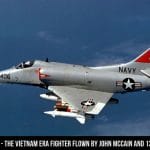In the Beginning – WWII
During WWII, both the British and Germans were able to capture each other’s aircraft by various means. Both sides would use these captured aircraft to train their own pilots on the weakness and strengths of the platforms they would face in air combat. This also occurred in the Pacific with the allies using Japanese aircraft.
Some senior pilots would be given the opportunity to fly these captured aircraft, which allowed other pilots to train against the same planes they would soon battle in aerial combat. To improve Air Combat Maneuvering (ACM), each side set up its own squadrons that would travel to airbases so all pilots could train.
During World War II, the British Royal Air Force unit responsible for Dissimilar Air Combat Training (DACT) was the Air Fighting Development Unit (AFDU). The AFDU pilots were tasked with developing tactics and training RAF and American fighter squadrons.
For the Germans, it was the Touring Zirkus Rosarius, named for the founder, Theodor Rosarius. These Luftwaffe pilots tested the British and American aircraft and toured operational German airfields across Europe to train their fighter pilots.
The Technical Air Intelligence Unit, TAIU, was the Allied military intelligence unit in the Pacific. This unit was formed among the allies of the Royal Air Force, the United States Army Air Forces, United States Navy, and Republic of China Air Force. Their goal was to recover Japanese aircraft in order to gather technical and capabilities data and train the Pacific Theater pilots.
In the following years, pilots kept their edge, experiencing aerial combat victories in the Korean War as the U.S. armed services still had men with experience in head-to-head combat from World War II. In Korea, the American pilots flying F-86 Sabres faced Chinese pilots flying the MiG-15. American pilots dominated the sky and the U.S. experienced a victory ratio of 10:1, with 792 MiGs lost versus 78 Sabres.
Following the Korean War, the United States reduced its emphasis on air combat maneuvering (ACM) due to the belief that daytime dogfighting was a thing of the past. The fighter jets of that era would include radars that would presumably put missiles onto their targets Beyond Visual Range (BVR). With this belief, less importance was placed on training pilots to dogfight.
During Vietnam, the very fast F-4 Phantom II, the primary fighter platform for the U.S., faced a nearly as fast, but very more nimble, MiG-21. The radar-guided missiles were very unreliable as most would not hit their target, especially at BVR, and some would not even release at all. Because of this lack of reliability of firing missiles at far-off targets, the pilots would need to maneuver behind the MiGs and fire multiple missiles simultaneously in order to have a chance at a kill. To make matters more difficult, the early F-4s did not have an internal gun. During the Vietnam War years of 1967-68, these circumstances created a less than spectacular U.S. kill-to-loss ratio of 2:1. Something needed to be done to increase the effectiveness during aerial combat of the American pilots.
Advanced Fighter Weapons School – Top Gun
In 1969, the United States Navy selected some of their best pilots to create a program that would train pilots to once again become the best dogfighters. The program would develop into the Advanced Fighter Weapons School, better known as Top Gun. The Navy pilots in their F-4s would go head-to-head with other Navy instructor pilots, demonstrating Vietnamese Air Force tactics in aircraft that mimicked the size, speed, and agility of the Vietnamese MiGs, like the A-4 Skyhawk and F-5 Tiger IIs. With Naval Aviators learning better aerial combat tactics, like how to take advantage of the MiG’s vulnerabilities, using more accurate missiles, and getting a new internal gun on the improved F-4, the Navy’s kill ration greatly improved after 1970 to 12:1.
The Air Force, who had not made adjustments in their training, did not see a great improvement in their kill ratio. Even with improvements to the F-4s missile tracking, adding the internal gun, and a new radar system that would improve situational awareness of the F-4 pilots, they still experienced a less than stellar air combat loss ratio. Therefore in 1972, the United States Air Force established its own Dissimilar Air Combat Training program to train its pilots in air combat.
64th and 18th Aggressor Squadron (AGRS)
The Air Force equivalent to the Navy’s Top Gun is the USAF Weapons School based at Nellis Air Force Base in Nevada. The unit would be named the 64th Aggressor Squadron, nicknamed the Aggressors, and would be equipped with T-38 Talons and F-5 Tiger IIs to train their pilots in aerial combat. The other USAF AGRS is the 18th Squadron nicknamed the Blue Foxes. Though the USAF aggressor squadron training was too late to make a difference during Vietnam, when pilots did meet enemy aircraft, they swore by the aerial combat tactics they had been taught.
Over the coming decades as the Cold War continued, aggressor units adopted Soviet-style tactics and even secretly acquired Russian fighters to further enhance pilot training. The adversarial training schools would become experts in the way the Soviet Union used air combat tactics in conjunction with ground operations. The U.S. jets were painted to mimic the Russian aircraft and even the pilots would wear uniforms to immerse themselves into the aggressor roles.
The Air Force continued to develop its programs like Red Flag, a large-scale exercise that gave pilots experience with operating in huge air operations with many different elements. The training was so successful that over the 40 year period of the F-15‘s service, it has racked up more than 100 dogfighting victories without one F-15 loss. Today, the 64th AGRS fly F-16C Fighting Falcons, which are painted in Russian camouflage schemes.
U.S. Marine Corps VMFT-401 “SNIPERS”
The Snipers, a Marine Corps Reserve fighter squadron, is the only adversary unit in the Marine Corps. The squadron was activated in 1986 and initially flew F-21A Kfirs, an Israeli built combat aircraft. Today, they are stationed at Marine Corps Air Station Yuma in Arizona and currently operate F-5E Tiger II’s. Besides adversarial air for training exercises, VMFT-401 also helps train new Marine Corps F/A-18 Hornet pilots. VMFT-401 pilots are reserve Marines and many are commercial airline pilots. They are experienced, highly trained, prior active duty Marine pilots and are experts in air combat tactics.
U.S. Navy PMA-226, VFC-12, VFC-13, and VFC-111
The three adversarial training units for the United States Navy are VFC-12 Fighting Omars, VFC-13 Saints, and VFC-111 Sundowners. Both -12 and -13 squadrons have flown both the A-4 Skyhawk and the F/A-18 Hornet. VFC-111 has only operated the F-5E Tiger II.
NAVAIR’s PMA-226 manages and supports specialized and proven platforms and systems including 16 aircraft types like the T-38, H-72, X-26, U-6, O-2, and sundowning/sundown inventories H-3, A-4, and more from three physical locations. PMA-226’s Adversary Team is responsible for the overall management of two Adversary platforms, which are used primarily for air-to-air training: 44 x F-5 N/Fs and 14 x F-16 A/Bs. PMA-226’s CAS Team is also responsible for the management of Contractor Owned / Contractor Operated (COCO) aircraft support to the Fleet and acquisition community.
VFC-12 has been assigned to Naval Air Station Oceana at Virginia Beach, Virginia since 1975. Originally designated VC-12 when established in 1943, they were a fighter squadron flying aboard the USS Card in the western Pacific. They flew the F4F Wildcat and TBM-1 Avenger over the Pacific Theater until the Card’s homeport was reassigned to Norfolk, at which time they began to fly combat missions in the Atlantic Theater.
VFC-13 was activated in 1973 in NAS New Orleans. Its first assigned aircraft was the F-8 Crusader and then in 1974 transitioned to the A-4 Skyhawk. In 1996, VFC-13 transferred to NAS Fallon and also switched to the F-5E Tiger II. VFC-13 provides adversarial training for both the Navy and Marine Corps squadrons, carrier wings, and USAF units.
VFC-111’s nickname is the Sundowners and is located at NAS Key West. They provide adversary air services and dissimilar air combat training, flying the F-5N Tiger IIs. Originally a detachment of VFC-13 established in 2005, VFC-111 became a full-time squadron in 2006.
Commercial/Contracted Adversary Services
Today the torch of the Adversary Air training program has been handed to commercial operators who fly former combat jets. Tactical Air Support (TacAir), Draken International, Airborne Tactical Advantage Company (ATAC), Top Aces (formerly Discovery Air Defence in Canada), Air USA, and a host of new entrants into this market own between 350 and 400 former wartime jets ready to fill the contracted air services demand from USN, USMC, and USAF. These jets range from US-made F-5, F-16, and A-4s to foreign-built Mirage, Cheetahs, L-159s, F-21 Kfir, Hawker Hunters, and even MiG aircraft.
Why contracted air services?
Between USAF, USN, and USMC, there are thousands of combat-ready jets, ranging from F-18, F-16, F-22, and F-35, so why do contracted air services exist?
These are 4 main reasons contracted air services exist:
- Dollars to operate the US military fleet: the US military faces a significant cost to operate its own wartime jets–tens of thousands per flight hour to operate. Shown below are estimated costs per flight hour of some of the more advanced fighters in the US inventory. The training schools are highly demanding on aircraft flying multiple sorties daily with up to dozens of aircraft needing to be available for larger exercises.
https://www.businessinsider.com/chart-shows-hourly-cost-of-military-aircraft-2014-12
Contracted air services can provide the level of effort required to fly ‘red air sorties’ enabling realistic ACM training for the ‘blue air’ US pilots at a fractional price compared to that of the government-operated aircraft. - Wear and tear on US fleet: Additional flight hours for training cause a drain on the life of any type of jet. Keeping hours off the United States’ active wartime fleet airframes is critical to the jets being available in the event of an international conflict.
- Capturing the experience of former military aviators: As US military pilots rotate out of active duty and into civilian life, all of that training goes with them. These are combat aviators with hundreds and even thousands of flight hours on multiple types of military jets. These include Top Gun and USAF Weapons School graduates and instructors, test pilots, and even astronauts who can provide invaluable training to current US military pilots.
- Providing 5th gen capabilities on a 4th gen aircraft for training: The ability to replicate a foreign threat at an affordable price is a highly desired commodity by the USAF, USN, and USMC. By teaming with forward-leaning industry partners, these commercial air service contractors can equip their jets with the latest modern technology to give the best training aides possible to US DoD pilots. Rather than relying on the airframe OEM to upgrade the jets with new sensors/avionics, which for 10 or even 20 aircraft would be prohibitively expensive, these contractors are commissioning their own upgrades such as the Duotech NEMESIS RADAR.
Who are the players & what type of aircraft
There are 4 major players in North America who provide air services on current contracts.
TacAir: Will take over the U.S. Navy (USN) Aggressor contract in the next few months. TacAir operates F-5 E/F aircraft equipped with a modern cockpit including Garmin’s moving map display, Mason modern hands-on throttle, and stick, and Duotech’s NEMESIS RADAR.
Airborne Tactical Advantage Company (ATAC): ATAC is the incumbent on the current USN Aggressor contract which will end in 2018. ATAC has operated Hawker Hunter and Kfir jets for the USN for the past decade.
Draken: They are the incumbent for the past several years on the USAF Nellis Aggressor contract, operating its L-159, Mirage F-1, and A-4 aircraft. Draken also won the follow-on contract in 2018 for USAF.
Top Aces: The current contract holder for Canadian Armed Forces, Top Aces has utilized the A-4 and BAE Hawk jets for the past several years. They also hold contracts in Europe and Australia for air services.
What it means to the future of air combat operations
Current US DoD contracts and RFQs in place will support contracted air services training for the next decade and will continue to grow in both size and scope. As warfare continues to evolve, so too will the threats from foreign aircraft manufacturers. These will include additional stealth, jamming, radar, and weapons, which US pilots must learn to both cope with and eliminate. By contracting the red air training to companies who privately own, operate, and advance these 3rd and 4th generation platforms, the US can constantly address pilot training shortfalls.
How Duotech is helping the Contracted Adversary Companies
Fighter squadrons face shortfalls in Adversary Air Support (AdAir) for combat training due to budgetary shortages and a lack of truly advanced threat replication. Duotech is providing low cost, but highly capable RADAR that represents current threat capabilities. Jets equipped with Nemesis RADAR are the best AdAir solution in the market today, with an unrivaled combination of performance and growth potential. Duotech Services has designed a purpose-built RADAR to support the AdAir market by presenting a solution that is:
- Highly capable of utilizing modern RADAR techniques
- Ability to quickly add additional RADAR capabilities to meet AdAir training requirements
- Generate threat replication via unclassified and classified means
- Deliver the most sustainable and maintainable RADAR system for the application









